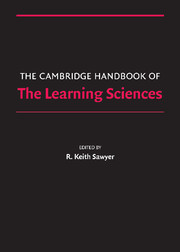Book contents
- Frontmatter
- Contents
- Preface
- Contributors
- 1 Introduction
- PART I FOUNDATIONS
- PART II METHODOLOGIES
- PART III THE NATURE OF KNOWLEDGE
- PART IV MAKING KNOWLEDGE VISIBLE
- PART V LEARNING TOGETHER
- PART VI LEARNING ENVIRONMENTS
- 28 Motivation and Cognitive Engagement in Learning Environments
- 29 Learning as a Cultural Process
- 30 Prospects for Transforming Schools with Technology- Supported Assessment
- 31 Internet Use in Schools
- 32 Teacher Learning Research and the Learning Sciences
- 33 Scaling Up
- 34 Conclusion
- Afterword: After How Comes What
- Epilogue: The Fundamental Issue in the Learning Sciences
- Author Index
- Subject Index
- References
28 - Motivation and Cognitive Engagement in Learning Environments
Published online by Cambridge University Press: 05 June 2012
- Frontmatter
- Contents
- Preface
- Contributors
- 1 Introduction
- PART I FOUNDATIONS
- PART II METHODOLOGIES
- PART III THE NATURE OF KNOWLEDGE
- PART IV MAKING KNOWLEDGE VISIBLE
- PART V LEARNING TOGETHER
- PART VI LEARNING ENVIRONMENTS
- 28 Motivation and Cognitive Engagement in Learning Environments
- 29 Learning as a Cultural Process
- 30 Prospects for Transforming Schools with Technology- Supported Assessment
- 31 Internet Use in Schools
- 32 Teacher Learning Research and the Learning Sciences
- 33 Scaling Up
- 34 Conclusion
- Afterword: After How Comes What
- Epilogue: The Fundamental Issue in the Learning Sciences
- Author Index
- Subject Index
- References
Summary
When learning environments are based on learning sciences principles (e.g. project, problem, and design approaches), they are more likely to be motivating for students. The principles – such as authenticity, inquiry, collaboration, and technology – engage learners so that they will think deeply about the content and construct an understanding that entails integration and application of the key ideas of the discipline. For a learning sciences approach to work, students must invest considerable mental effort and must persist in the search for solutions to problems. In many ways, newly designed environments based on learning sciences principles require students to be more motivated than do traditional environments (Blumenfeld et al., 1991). Although there is evidence that students respond positively to these learning environments (Hickey, Moore, & Pellegrino, 2001; Mistler-Jackson & Songer, 2000), it remains unclear whether students are willing to invest the time and energy necessary for gaining the desired level of understanding. Many classroom activities in which students enthusiastically participate do not necessarily get students cognitively engaged.
The concept of cognitive engagement couples ideas from motivation research with ideas regarding learning strategy use. It includes students' willingness to invest and exert effort in learning, while employing the necessary cognitive, metacognitive, and volitional strategies that promote understanding (Fredricks, Blumenfeld, & Paris, 2004). The use of strategies can be superficial or deep. Superficial cognitive engagement involves the use of memory and elaboration strategies.
Information
- Type
- Chapter
- Information
- The Cambridge Handbook of the Learning Sciences , pp. 475 - 488Publisher: Cambridge University PressPrint publication year: 2005
References
Accessibility standard: Unknown
Why this information is here
This section outlines the accessibility features of this content - including support for screen readers, full keyboard navigation and high-contrast display options. This may not be relevant for you.Accessibility Information
- 89
- Cited by
